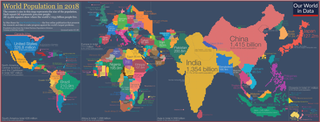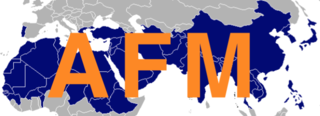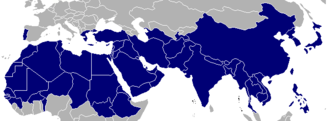
Cartography is the study and practice of making and using maps. Combining science, aesthetics and technique, cartography builds on the premise that reality can be modeled in ways that communicate spatial information effectively.

A geographic information system (GIS) consists of integrated computer hardware and software that store, manage, analyze, edit, output, and visualize geographic data. Much of this often happens within a spatial database, however, this is not essential to meet the definition of a GIS. In a broader sense, one may consider such a system also to include human users and support staff, procedures and workflows, the body of knowledge of relevant concepts and methods, and institutional organizations.

Environmental Systems Research Institute, Inc., doing business as Esri, is an American multinational geographic information system (GIS) software company headquartered in Redlands, California. It is best known for its ArcGIS products. With a 40% market share, Esri is the world's leading supplier of GIS software, web GIS and geodatabase management applications.

A cartogram is a thematic map of a set of features, in which their geographic size is altered to be directly proportional to a selected variable, such as travel time, population, or Gross National Product. Geographic space itself is thus warped, sometimes extremely, in order to visualize the distribution of the variable. It is one of the most abstract types of map; in fact, some forms may more properly be called diagrams. They are primarily used to display emphasis and for analysis as nomographs.

Waldo Rudolph Tobler was an American-Swiss geographer and cartographer. Tobler is regarded as one of the most influential geographers and cartographers of the late 20th century and early 21st century. He is most well known for coining what has come to be referred to as Tobler's first law of geography. He also coined what has come to be referred to as Tobler's second law of geography.
A GIS software program is a computer program to support the use of a geographic information system, providing the ability to create, store, manage, query, analyze, and visualize geographic data, that is, data representing phenomena for which location is important. The GIS software industry encompasses a broad range of commercial and open-source products that provide some or all of these capabilities within various information technology architectures.
Spatial network analysis software packages are analytic software used to prepare graph-based analysis of spatial networks. They stem from research fields in transportation, architecture, and urban planning. The earliest examples of such software include the work of Garrison (1962), Kansky (1963), Levin (1964), Harary (1969), Rittel (1967), Tabor (1970) and others in the 1960s and 70s. Specific packages address their domain-specific needs, including TransCAD for transportation, GIS for planning and geography, and Axman for Space syntax researchers.

ArcGIS is a family of client, server and online geographic information system (GIS) software developed and maintained by Esri.
Luis Bush is an Argentina-born Christian missionary and the president of the Transform World Connections.

Web mapping or an online mapping is the process of using, creating, and distributing maps on the World Wide Web, usually through the use of Web geographic information systems. A web map or an online map is both served and consumed, thus, web mapping is more than just web cartography, it is a service where consumers may choose what the map will show.
Traditional knowledge geographic information systems (GIS) are the data, techniques, and technologies designed to document and utilize local knowledges in communities around the world. Traditional knowledge is information that encompasses the experiences of a particular culture or society. Traditional knowledge GIS differ from ordinary cognitive maps in that they express environmental and spiritual relationships among real and conceptual entities. This toolset focuses on cultural preservation, land rights disputes, natural resource management, and economic development.

Geography is the study of the lands, features, inhabitants, and phenomena of Earth. Geography is an all-encompassing discipline that seeks an understanding of Earth and its human and natural complexities—not merely where objects are, but also how they have changed and come to be. While geography is specific to Earth, many concepts can be applied more broadly to other celestial bodies in the field of planetary science. Geography has been called "a bridge between natural science and social science disciplines."
Cartographic generalization, or map generalization, includes all changes in a map that are made when one derives a smaller-scale map from a larger-scale map or map data. It is a core part of cartographic design. Whether done manually by a cartographer or by a computer or set of algorithms, generalization seeks to abstract spatial information at a high level of detail to information that can be rendered on a map at a lower level of detail.
The Joshua Project is an evangelical Christian organization based in Colorado Springs, United States, which seeks to coordinate the work of missionary organizations to track the ethnic groups of the world with the fewest followers of evangelical Christianity. To do so, it maintains ethnologic data to support Christian missions. It also tracks the evangelism efforts among 17,446 people groups worldwide—a people group being "the largest group within which the Gospel can spread as a church planting movement," according to the project's website—to identify people groups as of yet unreached by Christian evangelism.

Anglican Frontier Missions is an American-based Christian mission organization that "To plant biblically-based, indigenous churches where the church is not, among the 2 billion people and 6,000+ unreached people groups still waiting to hear the Gospel for the very first time."
John Robb is the former Chairman for the International Prayer Council, and formerly led the prayer ministries of World Vision. The IPC is a network of regional and national prayer ministries and networks around the world. He and the IPC provided leadership for the World Prayer Assembly that was held in Jakarta, Indonesia, May 14–18, 2012.
In Christianity, an unreached people group refers to an ethnic group without an indigenous, self-propagating Christian church movement. Any ethnic or ethnolinguistic nation without enough Christians to evangelize the rest of the nation is an "unreached people group". It is a missiological term used by Evangelical Protestants. The Lausanne Committee for World Evangelization defines a people group as "the largest group within which the gospel can spread as a church planting movement without encountering barriers of understanding or acceptance." "Nation" is sometimes used interchangeably for "people group". The term is sometimes applied to ethnic groups in which less than 2% of the population is Evangelical Protestant Christian, Including nations where other forms of Christianity are prevalent such as Western Catholicism, Eastern Christianity or Lutheranism.
Counter-mapping is creating maps that challenge "dominant power structures, to further seemingly progressive goals". Counter-mapping is used in multiple disciplines to reclaim colonized territory. Counter-maps are prolific in indigenous cultures, "counter-mapping may reify, reinforce, and extend settler boundaries even as it seeks to challenge dominant mapping practices; and still, counter-mapping may simultaneously create conditions of possibility for decolonial ways of representing space and place." The term came into use in the United States when Nancy Peluso used it in 1995 to describe the commissioning of maps by forest users in Kalimantan, Indonesia, to contest government maps of forest areas that undermined indigenous interests. The resultant counter-hegemonic maps strengthen forest users' resource claims. There are numerous expressions closely related to counter-mapping: ethnocartography, alternative cartography, mapping-back, counter-hegemonic mapping, deep mapping and public participatory mapping. Moreover, the terms: critical cartography, subversive cartography, bio-regional mapping, and remapping are sometimes used interchangeably with counter-mapping, but in practice encompass much more.

Technical geography is the branch of geography that involves using, studying, and creating tools to obtain, analyze, interpret, understand, and communicate spatial information.

Internet GIS, or Internet geographic information system (GIS), is a term that refers to a broad set of technologies and applications that employ the Internet to access, analyze, visualize, and distribute spatial data. Internet GIS is an outgrowth of traditional GIS, and represents a shift from conducting GIS on an individual computer to working with remotely distributed data and functions. Two major issues in GIS are accessing and distributing spatial data and GIS outputs. Internet GIS helps to solve that problem by allowing users to access vast databases impossible to store on a single desktop computer, and by allowing rapid dissemination of both maps and raw data to others. These methods include both file sharing and email. This has enabled the general public to participate in map creation and make use of GIS technology.










